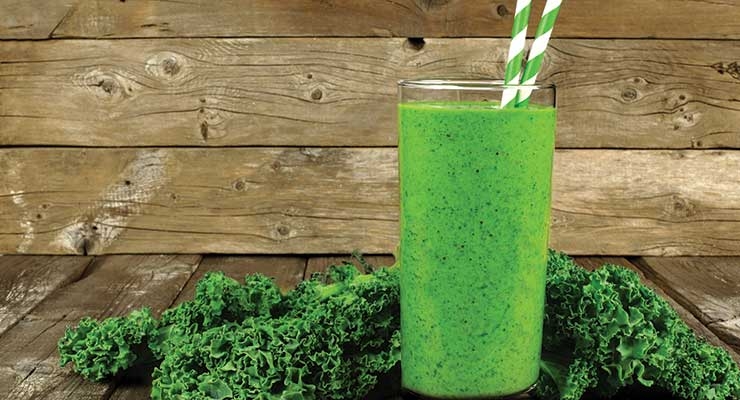Lisa Schofield, Contributing Writer04.03.17
Green is among the top adjectives affiliated with the natural products/health foods industry, and has several associations, including recycling/repurposing, sustainability, botanical products, as well as plant-based foods and supplements.
The category of green foods has evolved considerably, and is currently expansive and a bit amorphous; newer devotees of healthy living are including plant-based meat alternatives in that category—after all, plants are mostly green, right?
Traditionally, green foods have been part of the “super foods” category, noted Golan Raz, vice president of health & nutrition at Lycored, (part of Adama Group). During the last several years, there has been a clear transition in consumer focus from “super foods” to “whole foods” and this transition has impacted “green foods.” The popularity of greens such as kale has added to the category’s appeal and widening description. After five or so years of minimal growth, the plant-based category is being re-positioned as a “hot” category, Mr. Raz said. “With a growing awareness about a vegetable-based diet—and with the expansion in use of herbs in basic home cooking—botanical extractions and fruit- and vegetable-based whole foods supplements are enjoying the overall trend.”
Karen Hecht, PhD, technical marketing specialist, AstaReal Inc., Bellevue, WA, agreed, explaining, green (plant-based) foods are wholesome and valuable for health; overall, they are a solid source of phytonutrients and antioxidants as well as being low-calorie and high-fiber foods. However, she observed, it is still very difficult for most health-conscious Americans to consume 3-5 servings of vegetables plus 2-4 servings of fruit on a daily basis.
“This is where shakes, smoothies and supplements complete our dietary needs,” she said. “We’ve seen an expansion in the kind of plants people are incorporating into their diets. For example, we are rediscovering a truly ancient plant group in North America: algae These marine plants have long been popular in other parts of the world, where algae and algae-based products are consumed, including seaweed, spirulina and astaxanthin.”
The green foods for health category is more than 80 years old, according to Ron Seibold, co-founder, Pines International, Lawrence, KS. Originally researched by Charles Schnabel and his team, they discovered that cereal grasses such as wheat grass reached peak nutrition density at a certain time of growth, also known as “the jointing stage.”
They created a tablet and powder for consumers, which sold well until synthetic multivitamins began to dominate in the mid-century. This began to change with the publication of the book, The Save Your Life Diet by David Reuben, which discussed how healthy people who consumed whole food vegetables, fruits, nuts and grains—ingesting fiber and other nutrients—had much lower incidence of certain diseases. Based on the work of Dr. Reuben and Dr. Schnabel, Pines Wheat Grass was launched as the first green food for the health food retail channel.
When Bill Pine, director of business development, Natural Aloe Costa Rica (NACR), Liberia, Costa Rica, joined the industry in 1989 as sales manager for Aloecorp, interest in aloe was as a beverage consumed for digestive support. Today, he emphasized that aloe is now recognized by mainstream consumers (who ingest it and use it topically for relief after-sun exposure). This has necessitated not only increased production but improved processing methodologies.
NACR processes aloe under the ethanol extraction method without the use of enzymes, activated carbon or heat. “This preserves the natural properties of the fresh leaf as found in nature,” he explained. “This results in aloe powders that retain superior amounts of the acetylated mannans also known as acemannan.”
Wheat and other cereal grasses along with aloe remain a powerhouse of nutrition for today’s consumers who eagerly embrace and accept that a “green drink” means health, wellness and vibrant energy.
“Green foods as an umbrella category include a wide range of plant-based foods and supplements—from algae products like spirulina, astaxanthin, and kelp to vegetables like broccoli, spinach, and kale, passing through grasses like wheat and barley,” said Simon Seward, global business director, Algalif, Fort Lauderdale, FL. The diversity of what now constitutes “green foods” reflects industry growth and consumer behavior patterns, he added. “As we see it, there are three main drivers behind this development: consumers’ desire to improve overall health and wellness; the rise of vegetarians, vegans, and flexitarians; and the power of Millennials.
Consumers are eating more fresh, natural and minimally processed foods, and they are attracted to foods labeled as natural and organic, which are equated to being healthy. Meanwhile, he added, both Millennials and the older tier of Generation Z (late teens or so) “are especially health-centric. They are the consumer base that is most willing to pay a premium for health benefits.”
Giving this expanding category of green foods more of an adrenaline shot is the steep incline of Americans who consider themselves vegan, vegetarian or “flexitarian.” The latter describes people who still enjoy eating meat/animal products but also emphasize healthier vegetable/plant-based foods. According to Mr. Seward, “As a plant-based diet becomes more on trend, so does the demand for new products.” He citeed Innova Market Insights data that showed a 60% increase in global new food and beverage launches with vegetarian claims between 2011 and 2015.
Mark Thurston, president, AIDP, City of Industry, CA, noted that, “Advice coming from the scientific community about how to eat healthy has significantly changed over the past 10 years.” As an example, calorie restriction was the focus for losing weight, but more recently, the healthcare community has shifted that focus to ensuring optimal levels of nutrients are met through daily diet.
This begs the question, Mr. Thurston said: how can we best get these nutrients from food? The answer, he noted, is to consume natural foods that cross the color spectrum. Consumers are more educated about how different colored produce positively impacts health in certain areas.
Lawrence Blitz, president of Green Source Organics, Ventura, CA, agreed, saying there has been “a revolution of awareness” about the phytonutrient-green food category, which encompasses spirulina, chlorella, alfalfa barley, oat, and wheat grasses, and also now includes kale, broccoli, spinach, kelp, parsley, cabbage, collards and brussels sprouts. “We’ve observed the consumer seeking large quantities of individual green ingredients as well as blends for their convenience. There are many reasons consumers are seeking green food supplements; they may want the perfect protein, an alkalizing effect, increasing fiber in their diet, or they may be addressing specific health issues and targeting valuable compounds that these phytonutrients contain.”
Additionally, among health-conscious consumers, there is an increased focus on the quality of the nutrients, Dr. Hecht emphasized. “This means, in our case, the quality of ingredients used to grow the algae, and the health and cleanliness of the culture matters a lot because it impacts the quality and health benefits of the final product.” For example, while the algae that produce astaxanthin can be grown outdoors, doing so exposes the algae to biological and chemical contaminants. AstaReal astaxanthin is cultivated indoors, enabling the maintenance of the integrity and health of the algae so that they produce astaxanthin efficiently and the final product is free of contaminants associated with outdoor cultivation. Algalif, according to Mr. Seward, also cultivates freshwater microalgae (both are species Haematococcus pluvialis) in an indoor cGMP-compliant facility.
Getting Green Specific
Modern green foods are now more than just optimized wholesome nutrition; they also can be condition-specific. And this creates tremendous new formulating opportunities for the category.
As another red carotenoid, Lycored’s proprietary tomato whole-food extract, Lyco-O-Mato, has been shown to provide nutraceutical support for the prostate. Recently, a double-blind, placebo-controlled crossover study showed that supplementation with lycopene (or lutein) can protect skin against UV radiation; this makes the carotenoid a natural addition to sun care formulas and overall skin health (British Journal of Dermatology, 2016).
According to Mr. Thurston, kiwi has been shown to improve aspects of gastrointestinal health, including altering the microbial ecology of the colonic environment (Plant Foods for Human Nutrition, 2012). For example, in New Zealand, kiwi is consumed in quantity as a solution for mild constipation. These benefits are thought to be derived from the inherent levels of digestion-resistant carbohydrates (DRC), polyphenols and vitamin C.
AIDP, in conjunction with its New Zealand-based partner Anagenix, have introduced a patented golden kiwi extract powder, Livaux. Livaux is premium-sourced, whole gold kiwi from which the skin and seeds are removed, and cold processed into a powder form for use in supplements and functional foods. “Livaux has been recently shown in a randomized, double-blind, placebo-controlled clinical study to significantly increase mean daily bowel movements,” Mr. Thurston said. “In addition, Livaux increased the concentration of F. prausnitzii in functionally constipated participants. This implies a beneficial outcome as the organism is known to grow in the large bowel and generate butyrate, which has protective functions/health benefits in the gut,” (Advances in Food and Nutrition Research, 2013)
Astaxanthin has several health benefits; first, it is a viable addition to any antioxidant formula for overall health and immunity, according to Dr. Hecht. “Dietary antioxidants are important when our own endogenous antioxidants become overwhelmed under conditions of stress (e.g., exercise) or less efficient as we age.”
Summarizing results from a PubMed search, Mr. Seward commented, “astaxanthin protects against free radical damage, preserves healthy lipids, proteins and DNA, and helps the human body maintain a healthy state. The numerous health benefits of natural astaxanthin are documented by extensive research, including 35 clinical trials with human subjects and more than 240 peer-reviewed papers.”
Dr. Hecht expounded that astaxanthin “really shines” in condition-specific support, notably for physical energy, thus making the carotenoid an attractive addition to any fitness formula. “Astaxanthin encourages muscle performance and recovery by supporting the energy-producing mitochondria that are found in muscle. While mitochondria produce the energy molecule ATP, they also produce damaging free radicals that actually harm themselves and muscle tissues. Astaxanthin neutralizes free radicals and also encourages mitochondria to use lipids preferentially as an energy source, which provides more energy and translates to better endurance.”
According to Dr. Hecht, the greatest potential for astaxanthin from a marketing perspective lies in the fitness industry and competitive athletes. For athletic performance, amino acids (such as branched chain amino acids) help muscles work and encourage muscle growth, so “adding astaxanthin to the mix helps muscles sustain the stress of exercise for longer and improves recovery after exercise.” Plant-based fats (triglycerides) are often included in energy drinks and foods to enhance physical output, and astaxanthin synergizes well by increasing muscles’ preference to use these fats instead of sugar for energy, a process that leaves fatigue, muscle soreness and blood sugar crashes in its wake.
Astaxanthin also benefits cardiovascular health because it gets incorporated into particles in blood that carry cholesterol. Astaxanthin slows down oxidation of LDL cholesterol and increases HDL cholesterol. Astaxanthin also improves circulation in the capillaries, which means tissues are better nourished and oxygenated.
Product Possibilities
Customers are using Green Source Organics’ organic and conventional phytonutrients and green powders in a variety of ways, including drink mixes, meal replacements, tablets and capsules, functional foods and snacks such as bars and bar coatings, according to Mr. Blitz. “Our R&D baker is creating unique functional bakery and confections to enhance palatability and appearance.”
Lina Cekaite, PhD, science manager of Algalif, said, “formulators have plenty of choice with astaxanthin ingredients, which include oleoresins, powders, beadlets and dispersible options, enabling the incorporation of astaxanthin in functional foods, beverages and other product formats.”
Dr. Hecht added that convenience is especially important for consumers today, and she revealed that AstaReal is working to incorporate astaxanthin into foods and beverages that are easily consumed on the go, like shots, energy bars, and gummies.
In Mr. Seibold’s view, due to increased recognition of favoring whole foods rather than their juices, the sales of whole food cereal grass and alfalfa products will grow significantly in the future. Although cereal grass and alfalfa are often mixed with less nutrient-dense vegetables and fruits, as long as the blend is made up of mostly whole foods containing fiber, they can help sustain good health. He urged brand marketers and formulators to refrain from using less nutrient-dense green foods. “Although some companies claim that adding less nutrient-dense vegetables and fruits improves flavor, the main reason for making complex blends with these inexpensive ingredients is to lower cost. But they tend to dilute the efficacy of more nutrient-dense cereal grasses that are part of the mixtures.”
As formulations encompass nutrition from a range of sources, Mr. Raz advised, “the basic rule says ‘mix fruits and vegetables to consume all the main colors nature has to offer.’ Lycopene (red), beta-carotene (orange), lutein (yellow) and astaxanthin (deep-brown/light red) are all healthy partners for a great green-based formula.”
Conclusions & Predictions
Once reserved for vegans and vegetarians, plant-based products are attracting a wider audience of health-conscious consumers, Mr. Seward said, citing a study (commissioned by Earth Balance), which reported that 42% of consumers know more about plant-based diets now compared to five years ago. Meanwhile, he cautioned, “that does not mean they are willing to compromise on price, taste and convenience.”
Mr. Raz noted that people are paying more attention to product origins and sources, looking for minimal intervention during harvesting, processing and production. “Consumers are asking to see technological advancement from one side and minimal intervention in the natural properties of the plant from the other side.“
Dr. Hecht predicted the industry will see a movement toward biodynamic farming, and hopefully standards developed for algae, which she said do not fit into the USDA National Organic Program (NOP) because they are not cultivated in soil.
More consumers, especially millennials, are committed to promoting social issues, not only focusing their time and resources on charitable, healthy and sustainable endeavors, but also choosing to support companies and brands that do so as well. If brands and green food/whole food/plant-based products are targeted toward this younger adult set, it would be wise to creatively tie-in ecologically friendly, sustainable and humane messaging.
The category of green foods has evolved considerably, and is currently expansive and a bit amorphous; newer devotees of healthy living are including plant-based meat alternatives in that category—after all, plants are mostly green, right?
Traditionally, green foods have been part of the “super foods” category, noted Golan Raz, vice president of health & nutrition at Lycored, (part of Adama Group). During the last several years, there has been a clear transition in consumer focus from “super foods” to “whole foods” and this transition has impacted “green foods.” The popularity of greens such as kale has added to the category’s appeal and widening description. After five or so years of minimal growth, the plant-based category is being re-positioned as a “hot” category, Mr. Raz said. “With a growing awareness about a vegetable-based diet—and with the expansion in use of herbs in basic home cooking—botanical extractions and fruit- and vegetable-based whole foods supplements are enjoying the overall trend.”
Karen Hecht, PhD, technical marketing specialist, AstaReal Inc., Bellevue, WA, agreed, explaining, green (plant-based) foods are wholesome and valuable for health; overall, they are a solid source of phytonutrients and antioxidants as well as being low-calorie and high-fiber foods. However, she observed, it is still very difficult for most health-conscious Americans to consume 3-5 servings of vegetables plus 2-4 servings of fruit on a daily basis.
“This is where shakes, smoothies and supplements complete our dietary needs,” she said. “We’ve seen an expansion in the kind of plants people are incorporating into their diets. For example, we are rediscovering a truly ancient plant group in North America: algae These marine plants have long been popular in other parts of the world, where algae and algae-based products are consumed, including seaweed, spirulina and astaxanthin.”
The green foods for health category is more than 80 years old, according to Ron Seibold, co-founder, Pines International, Lawrence, KS. Originally researched by Charles Schnabel and his team, they discovered that cereal grasses such as wheat grass reached peak nutrition density at a certain time of growth, also known as “the jointing stage.”
They created a tablet and powder for consumers, which sold well until synthetic multivitamins began to dominate in the mid-century. This began to change with the publication of the book, The Save Your Life Diet by David Reuben, which discussed how healthy people who consumed whole food vegetables, fruits, nuts and grains—ingesting fiber and other nutrients—had much lower incidence of certain diseases. Based on the work of Dr. Reuben and Dr. Schnabel, Pines Wheat Grass was launched as the first green food for the health food retail channel.
When Bill Pine, director of business development, Natural Aloe Costa Rica (NACR), Liberia, Costa Rica, joined the industry in 1989 as sales manager for Aloecorp, interest in aloe was as a beverage consumed for digestive support. Today, he emphasized that aloe is now recognized by mainstream consumers (who ingest it and use it topically for relief after-sun exposure). This has necessitated not only increased production but improved processing methodologies.
NACR processes aloe under the ethanol extraction method without the use of enzymes, activated carbon or heat. “This preserves the natural properties of the fresh leaf as found in nature,” he explained. “This results in aloe powders that retain superior amounts of the acetylated mannans also known as acemannan.”
Wheat and other cereal grasses along with aloe remain a powerhouse of nutrition for today’s consumers who eagerly embrace and accept that a “green drink” means health, wellness and vibrant energy.
“Green foods as an umbrella category include a wide range of plant-based foods and supplements—from algae products like spirulina, astaxanthin, and kelp to vegetables like broccoli, spinach, and kale, passing through grasses like wheat and barley,” said Simon Seward, global business director, Algalif, Fort Lauderdale, FL. The diversity of what now constitutes “green foods” reflects industry growth and consumer behavior patterns, he added. “As we see it, there are three main drivers behind this development: consumers’ desire to improve overall health and wellness; the rise of vegetarians, vegans, and flexitarians; and the power of Millennials.
Consumers are eating more fresh, natural and minimally processed foods, and they are attracted to foods labeled as natural and organic, which are equated to being healthy. Meanwhile, he added, both Millennials and the older tier of Generation Z (late teens or so) “are especially health-centric. They are the consumer base that is most willing to pay a premium for health benefits.”
Giving this expanding category of green foods more of an adrenaline shot is the steep incline of Americans who consider themselves vegan, vegetarian or “flexitarian.” The latter describes people who still enjoy eating meat/animal products but also emphasize healthier vegetable/plant-based foods. According to Mr. Seward, “As a plant-based diet becomes more on trend, so does the demand for new products.” He citeed Innova Market Insights data that showed a 60% increase in global new food and beverage launches with vegetarian claims between 2011 and 2015.
Mark Thurston, president, AIDP, City of Industry, CA, noted that, “Advice coming from the scientific community about how to eat healthy has significantly changed over the past 10 years.” As an example, calorie restriction was the focus for losing weight, but more recently, the healthcare community has shifted that focus to ensuring optimal levels of nutrients are met through daily diet.
This begs the question, Mr. Thurston said: how can we best get these nutrients from food? The answer, he noted, is to consume natural foods that cross the color spectrum. Consumers are more educated about how different colored produce positively impacts health in certain areas.
Lawrence Blitz, president of Green Source Organics, Ventura, CA, agreed, saying there has been “a revolution of awareness” about the phytonutrient-green food category, which encompasses spirulina, chlorella, alfalfa barley, oat, and wheat grasses, and also now includes kale, broccoli, spinach, kelp, parsley, cabbage, collards and brussels sprouts. “We’ve observed the consumer seeking large quantities of individual green ingredients as well as blends for their convenience. There are many reasons consumers are seeking green food supplements; they may want the perfect protein, an alkalizing effect, increasing fiber in their diet, or they may be addressing specific health issues and targeting valuable compounds that these phytonutrients contain.”
Additionally, among health-conscious consumers, there is an increased focus on the quality of the nutrients, Dr. Hecht emphasized. “This means, in our case, the quality of ingredients used to grow the algae, and the health and cleanliness of the culture matters a lot because it impacts the quality and health benefits of the final product.” For example, while the algae that produce astaxanthin can be grown outdoors, doing so exposes the algae to biological and chemical contaminants. AstaReal astaxanthin is cultivated indoors, enabling the maintenance of the integrity and health of the algae so that they produce astaxanthin efficiently and the final product is free of contaminants associated with outdoor cultivation. Algalif, according to Mr. Seward, also cultivates freshwater microalgae (both are species Haematococcus pluvialis) in an indoor cGMP-compliant facility.
Getting Green Specific
Modern green foods are now more than just optimized wholesome nutrition; they also can be condition-specific. And this creates tremendous new formulating opportunities for the category.
As another red carotenoid, Lycored’s proprietary tomato whole-food extract, Lyco-O-Mato, has been shown to provide nutraceutical support for the prostate. Recently, a double-blind, placebo-controlled crossover study showed that supplementation with lycopene (or lutein) can protect skin against UV radiation; this makes the carotenoid a natural addition to sun care formulas and overall skin health (British Journal of Dermatology, 2016).
According to Mr. Thurston, kiwi has been shown to improve aspects of gastrointestinal health, including altering the microbial ecology of the colonic environment (Plant Foods for Human Nutrition, 2012). For example, in New Zealand, kiwi is consumed in quantity as a solution for mild constipation. These benefits are thought to be derived from the inherent levels of digestion-resistant carbohydrates (DRC), polyphenols and vitamin C.
AIDP, in conjunction with its New Zealand-based partner Anagenix, have introduced a patented golden kiwi extract powder, Livaux. Livaux is premium-sourced, whole gold kiwi from which the skin and seeds are removed, and cold processed into a powder form for use in supplements and functional foods. “Livaux has been recently shown in a randomized, double-blind, placebo-controlled clinical study to significantly increase mean daily bowel movements,” Mr. Thurston said. “In addition, Livaux increased the concentration of F. prausnitzii in functionally constipated participants. This implies a beneficial outcome as the organism is known to grow in the large bowel and generate butyrate, which has protective functions/health benefits in the gut,” (Advances in Food and Nutrition Research, 2013)
Astaxanthin has several health benefits; first, it is a viable addition to any antioxidant formula for overall health and immunity, according to Dr. Hecht. “Dietary antioxidants are important when our own endogenous antioxidants become overwhelmed under conditions of stress (e.g., exercise) or less efficient as we age.”
Summarizing results from a PubMed search, Mr. Seward commented, “astaxanthin protects against free radical damage, preserves healthy lipids, proteins and DNA, and helps the human body maintain a healthy state. The numerous health benefits of natural astaxanthin are documented by extensive research, including 35 clinical trials with human subjects and more than 240 peer-reviewed papers.”
Dr. Hecht expounded that astaxanthin “really shines” in condition-specific support, notably for physical energy, thus making the carotenoid an attractive addition to any fitness formula. “Astaxanthin encourages muscle performance and recovery by supporting the energy-producing mitochondria that are found in muscle. While mitochondria produce the energy molecule ATP, they also produce damaging free radicals that actually harm themselves and muscle tissues. Astaxanthin neutralizes free radicals and also encourages mitochondria to use lipids preferentially as an energy source, which provides more energy and translates to better endurance.”
According to Dr. Hecht, the greatest potential for astaxanthin from a marketing perspective lies in the fitness industry and competitive athletes. For athletic performance, amino acids (such as branched chain amino acids) help muscles work and encourage muscle growth, so “adding astaxanthin to the mix helps muscles sustain the stress of exercise for longer and improves recovery after exercise.” Plant-based fats (triglycerides) are often included in energy drinks and foods to enhance physical output, and astaxanthin synergizes well by increasing muscles’ preference to use these fats instead of sugar for energy, a process that leaves fatigue, muscle soreness and blood sugar crashes in its wake.
Astaxanthin also benefits cardiovascular health because it gets incorporated into particles in blood that carry cholesterol. Astaxanthin slows down oxidation of LDL cholesterol and increases HDL cholesterol. Astaxanthin also improves circulation in the capillaries, which means tissues are better nourished and oxygenated.
Product Possibilities
Customers are using Green Source Organics’ organic and conventional phytonutrients and green powders in a variety of ways, including drink mixes, meal replacements, tablets and capsules, functional foods and snacks such as bars and bar coatings, according to Mr. Blitz. “Our R&D baker is creating unique functional bakery and confections to enhance palatability and appearance.”
Lina Cekaite, PhD, science manager of Algalif, said, “formulators have plenty of choice with astaxanthin ingredients, which include oleoresins, powders, beadlets and dispersible options, enabling the incorporation of astaxanthin in functional foods, beverages and other product formats.”
Dr. Hecht added that convenience is especially important for consumers today, and she revealed that AstaReal is working to incorporate astaxanthin into foods and beverages that are easily consumed on the go, like shots, energy bars, and gummies.
In Mr. Seibold’s view, due to increased recognition of favoring whole foods rather than their juices, the sales of whole food cereal grass and alfalfa products will grow significantly in the future. Although cereal grass and alfalfa are often mixed with less nutrient-dense vegetables and fruits, as long as the blend is made up of mostly whole foods containing fiber, they can help sustain good health. He urged brand marketers and formulators to refrain from using less nutrient-dense green foods. “Although some companies claim that adding less nutrient-dense vegetables and fruits improves flavor, the main reason for making complex blends with these inexpensive ingredients is to lower cost. But they tend to dilute the efficacy of more nutrient-dense cereal grasses that are part of the mixtures.”
As formulations encompass nutrition from a range of sources, Mr. Raz advised, “the basic rule says ‘mix fruits and vegetables to consume all the main colors nature has to offer.’ Lycopene (red), beta-carotene (orange), lutein (yellow) and astaxanthin (deep-brown/light red) are all healthy partners for a great green-based formula.”
Conclusions & Predictions
Once reserved for vegans and vegetarians, plant-based products are attracting a wider audience of health-conscious consumers, Mr. Seward said, citing a study (commissioned by Earth Balance), which reported that 42% of consumers know more about plant-based diets now compared to five years ago. Meanwhile, he cautioned, “that does not mean they are willing to compromise on price, taste and convenience.”
Mr. Raz noted that people are paying more attention to product origins and sources, looking for minimal intervention during harvesting, processing and production. “Consumers are asking to see technological advancement from one side and minimal intervention in the natural properties of the plant from the other side.“
Dr. Hecht predicted the industry will see a movement toward biodynamic farming, and hopefully standards developed for algae, which she said do not fit into the USDA National Organic Program (NOP) because they are not cultivated in soil.
More consumers, especially millennials, are committed to promoting social issues, not only focusing their time and resources on charitable, healthy and sustainable endeavors, but also choosing to support companies and brands that do so as well. If brands and green food/whole food/plant-based products are targeted toward this younger adult set, it would be wise to creatively tie-in ecologically friendly, sustainable and humane messaging.























